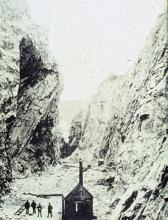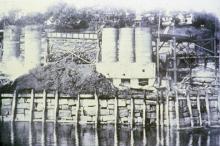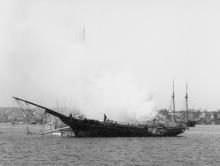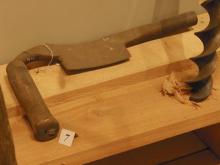Nineteenth Century Industries: Lime
Resources, labor, and markets linked many Penobscot Bay industries to each other. The limeLime
Calcium oxide (CaO), obtained from limestone, and used in mortars, plasters, cement, bleaching powder, and in making paper, glass, and steel. industry, based on a narrow 3-mile long band running from Thomaston to Camden, depended on wood—to fire the kilns and to build casks for the finished lime, used in plasterPlaster
A combination of lime or gypsum, sand, water, and sometimes hair or other fiber applied in a paste form to walls, ceilings, etc., and allowed to harden. and mortarMortar
A mixture of lime and/or cement, with sand and water, used as a bond between bricks or stones..
LimestoneLimestone limerock
A sedimentary rock consisting mostly of calcium carbonate, formed from fossilized skeletons of marine microorganisms and coral. Limestone is used as a building stone and to make lime. was found early in the colonial period, but was first made into lime commercially in 1733 in Thomaston. In 1836, the area produced 700,000 casks; in 1869, Rockland alone produced more than 1.1 million casks of lime. The industry peaked in 1892, when more than 1.4 million casks were produced in Rockland.
Limestone (calcium carbonate) is a sedimentarySedimentary sediment
In geology, refers to the kind of rock formed by sediment, or matter that settles to the bottom of water or is deposited by water, ice, or air. Limestone is a kind of sedimentary rock. rock formed from the calcifiedCalcify calcify; calcification
To harden, because of deposit of calcium salts. remains of ancient marine animals. When burned, it produces lime (calcium oxide) and carbon dioxide. Kilns, 28 to 36 feet high and eight feet in diameter, used wood or coal to burn limestone. In the nineteenth century, Knox County’s kilns were primarily wood fired. A kiln was loaded with a cord of wood at the bottom, and then filled with limestone broken into head-sized pieces. Lime was taken from the kiln and loaded into casks. A typical kiln produced 20,000 casks of lime and used 1,000 cords of wood annually. Advances in kiln design allowed them to work continuously. In 1890, Rockland had sixty-eight of the ninety-six kilns in Knox County. To cut the animal and human labor needed to move limestone from quarry to kiln, the Limerock Railroad was built in1890 in Rockland and Rockport. Trains ran on trestlesTrestle
A bridge, usually over marshes or low points in land, for railroads. Usually made up of many short spans., so that limestone could be dumped into the top of the kilns.
By the 1880’s most of the kilnwood needed was imported from the St. John, New Brunswick area. Nicknamed Johnny Wood BoatsJohnny Wood Boat
Boats from St. John River area in New Brunswick, that carried cordwood to Maine's lime kilns. More formally called St. John river woodboat.
Read More, dozens of small Canadian schooners entered Rockland and Rockport. This trade eventually declined due to cordwood carried by railroad from Maine’s interior and the gradual conversion from wood to coal starting in the 1890s.
Larger lime companies owned schooners that carried filled casks to Boston or New York. Lime was a dangerous cargo: if it got wet, a chemical reaction created heat and sometimes caused the schooner to catch fire. Water could not put it out; the only way to save the vessel was by smothering the fire.
Lime was put into barrels or casks made by coopersCooper
One who makes casks and barrels for oil, water, wine, or other liquid and solid materials. In Penobscot Bay, coopers made thousands of casks for the lime trade. Also, a dock-worker who takes care of repairs or reconditioning to damaged packages or cases.. Hundreds of thousands of spruceSpruce
An evergreen, coniferous tree related to the pine. casks were needed each year. Coopers made both complete casks and shooksShooks stave
Barrel staves bundled for export. A stave is a narrow piece of softwood about 42 inches long, used to form the sides of the finished barrel., or disassembled barrels.
Rockland’s lime industry faltered after the turn of the century, due to competition from new building materials, lime from other places and higher costs. Despite consolidating the independent quarry businesses, Rockland’s kilns slowly began to close, and by 1950 were completely gone. Rockland’s lime businesses survived until then because new markets opened in the papermaking industry, in agriculture, and in making cementCement
Mixture of clay, lime, and other materials ground to a powder and heated together so that the mixture combines (sintering).. Today, neighboring Thomaston’s Dragon Cement Plant, built in 1928, uses local lime. It is the largest cement plant in New England, and ships its products by bargeBarge
The general name given to a flat-bottomed rigged or unrigged craft with a full body and heavy construction. Usually for transportation of bulky freight such as coal, lumber, sand, or stone. through Rockland.





